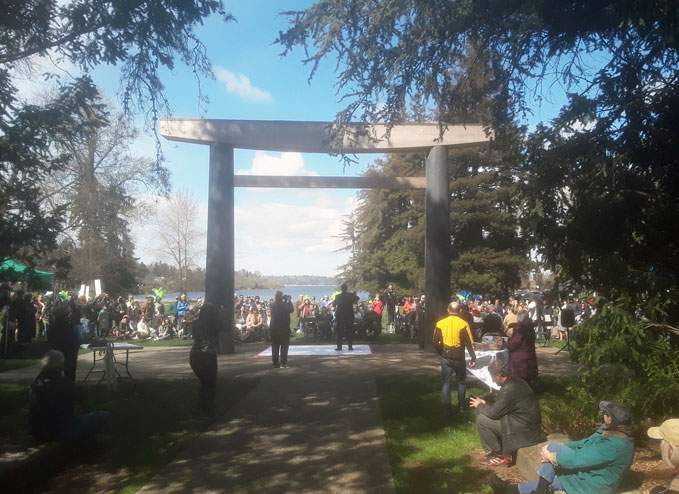By N.A.P.
Seattle Parks and Recreation, Seattle Parks Foundation, Seattle Department of Neighborhoods and the Friends of Seward Park invited all to celebrate the new torii gate at Seward Park on Saturday, April 2. The celebration included taiko drummers (School of Taiko), sakura dancer Akemi Burns, and remarks from 37th District Representative Sharon Tomiko Santos, Mayor Bruce Harrell, poet Larry Matsuda, and others.
The new torii is built “Northwest style” with basalt columns and cedar crosspieces. It is located in Seward Park’s north meadow and welcomes all who enter the park (5902 Lake Washington Blvd. S.).
To initiate the project, the Department of Neighborhoods awarded a planning grant to the Friends of Seward Park, which in turn hired landscape architectural firm Murase Associates to design the torii. Murase worked with the Friends of Seward Park to gather community input. Community participants then chose a design that honors the original Seward Park torii, addresses long-term maintenance concerns, and reflects current community values and the wilderness character of the park. The columns (hashira) of the torii are made of natural basalt columns from central Washington. One giant western red cedar tree harvested on Vancouver Island provided the timber for the lintel (kasagi) and crosspiece (nuki). Seattle Parks Foundation supported the Friends of Seward Park and together they successfully raised $347,000 for the project.

Seattle Parks and Recreation managed the construction of the new torii gate. It replaces the 26-foot timber torii built by master-carpenter Kichisaburo Ishimitsu at the Seattle Japanese Language School, and given to the city by Seattle’s Japanese Chamber of Commerce in 1934 as a representation of intercultural friendship. The gift was intended to help promote Seattle as a “Gateway to the Orient” during its International Potlatch celebration, the predecessor of today’s Seafair. That torii was then placed in Seward Park.
The original torii was removed in the mid-1980s due to decaying beams. Like the original Seward Park torii, the new design takes inspiration from the famous “floating” torii of Itsukushima shrine at Miyajima, Japan. The hashira are tapered upward like the camphor trees that form the hashira at Miyajima. The project includes a pathway and plaza that meet ADA requirements.




